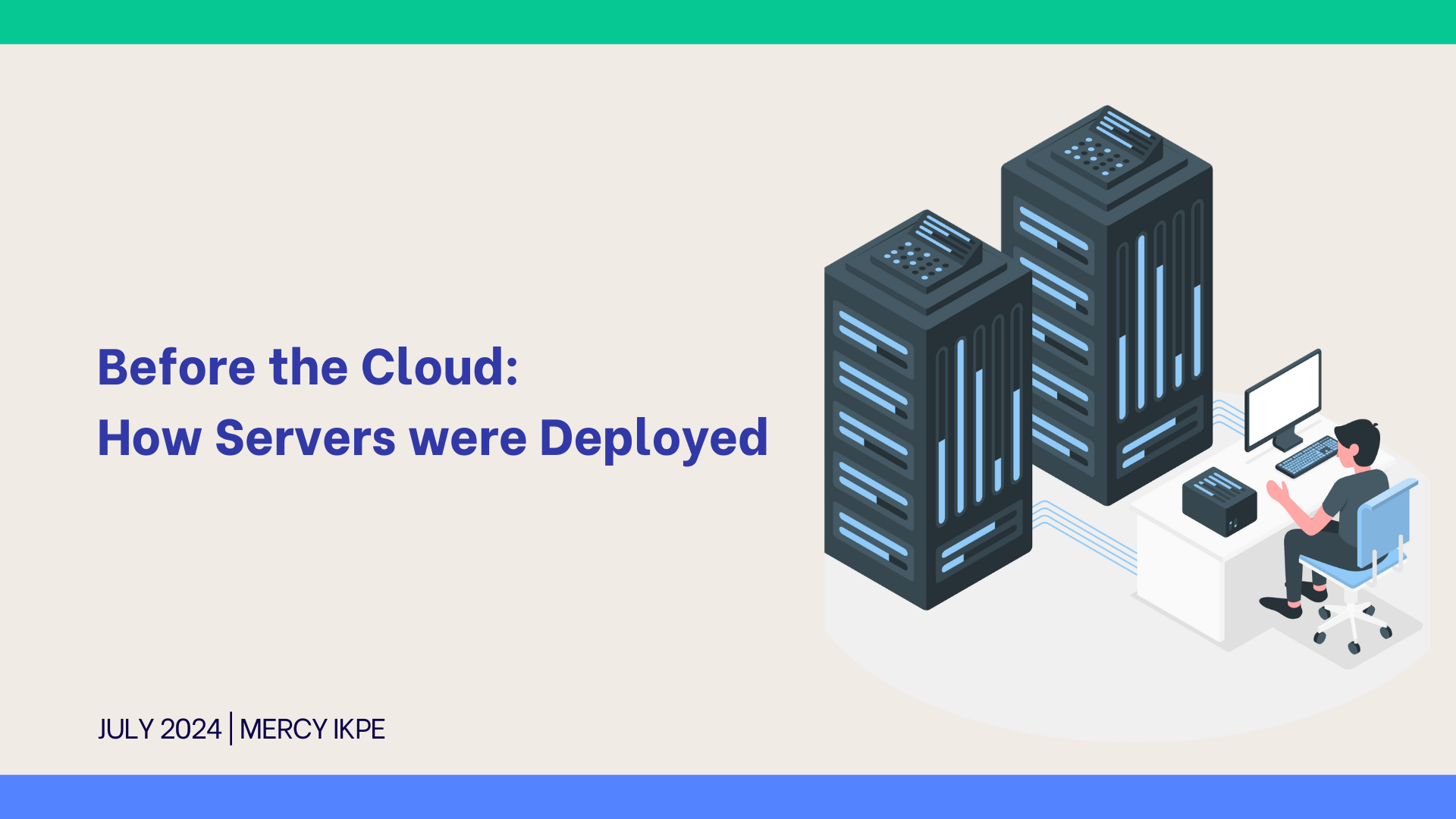Before the Cloud: How Servers were deployed
 Mercy Ikpe
Mercy IkpeTable of contents

Imagine you need a computer to do some work.
Option 1: Buy your computer. You'll own it, set it up, and fix any problems.
Option 2: Rent a computer from a company. You don't have to worry about setup or maintenance, the company does it. You can use the computer from anywhere.
Key differences:
Ownership: With option 1, you own the computer. With option 2, you rent the computer.
Setup and Maintenance: In option 1, you handle setup and maintenance. In option 2, the provider takes care of these tasks.
Cost: Buying a computer is a one-time expense. Renting a computer is an ongoing cost.
Flexibility: In option 1, computers stay the same. In option 2, computers can be changed based on your needs.
Traditional Server Deployment
Option 1 in the computer illustration refers to traditional server deployment, also known as on-premises deployment. Before cloud computing, organizations owned and managed physical data centres for their servers. Option 2 refers to cloud computing.
Key characteristics of traditional server deployment:
On-premises infrastructure: All hardware (servers, storage, networking equipment) was located within the organization's physical facilities.
High upfront costs: Buying and setting up hardware, building and maintaining data centres were expensive.
Limited scalability: Adding or removing servers was a time-consuming process involving physical hardware installation and configuration.
Geographical limitations: Server locations were restricted to the physical location of the data centre which made it difficult to serve customers in different regions effectively.
Traditional server deployment process:
Hardware procurement: Buying servers, storage, and network equipment.
Data centre setup: Building or renting a facility with power, cooling, and security.
Server installation: Placing physical servers in racks.
Network configuration: Connecting servers using switches and routers.
Software installation: Installing operating systems and applications.
Configuration: Setting up servers for performance, security, and availability.
Alternative Deployment Methods
Companies without resources for on-premises deployment had options:
Colocation Facilities: Renting physical space in a larger data centre.
Dedicated Hosting: Renting a dedicated server from a hosting provider.
Shared Hosting: Sharing a server with multiple websites.
These methods offered partial outsourcing of IT infrastructure.
Cloud Computing
Cloud computing provides IT resources over the Internet on a pay-as-you-go basis. Instead of purchasing, owning and maintaining physical data centres and servers, you can access technology services such as computing power, storage and databases on demand through providers such as Amazon Web Services (AWS), Microsoft Azure, Google Cloud, Linode, etc.
Benefits of Cloud Computing
On-demand self-service: Users can access and provision computing resources (servers, storage, networking) and pay for what they consume.
Broad network access: Resources are available over the internet and can be accessed from various devices.
Resource pooling: Cloud providers utilize a shared pool of resources to serve multiple customers.
Rapid elasticity: Resources can be quickly scaled up or down to meet changing demands.
Measured service: Users pay only for the resources they consume.
Alternative Cloud deployment
Hybrid Cloud: A hybrid cloud combines on-premises infrastructure and cloud services. Organizations can use this approach to meet specific needs, such as handling sensitive data on-premises while using the cloud for other workloads.
Conclusion
While traditional hosting methods still exist, cloud computing has become the preferred choice for many due to its scalability, flexibility, cost-efficiency, and global reach. The best option depends on an organization's needs, budget, and risk tolerance.
While these traditional hosting methods still exist, Cloud Computing has become the preferred choice for many organizations due to its:
Scalability: The ability to quickly adjust resources based on demand.
Flexibility: A wide range of services and deployment models, Infrastructure as a Service (Iaas), Platform-as-a-Service (Paas), and Software-as-a-Service (Saas).
Cost-efficiency: Pay-as-you-go pricing and reduced upfront costs.
Global reach: Extensive data centre networks for low latency.
In summary, cloud computing has not entirely replaced traditional hosting methods but has increased the options available to businesses. The choice between cloud, traditional hosting or hybrid cloud often depends on the specific needs, budget, and risk tolerance of the business.
Resources:
What is a Data Center? click here to watch
Inside a Google data center. Click here to watch
Subscribe to my newsletter
Read articles from Mercy Ikpe directly inside your inbox. Subscribe to the newsletter, and don't miss out.
Written by
